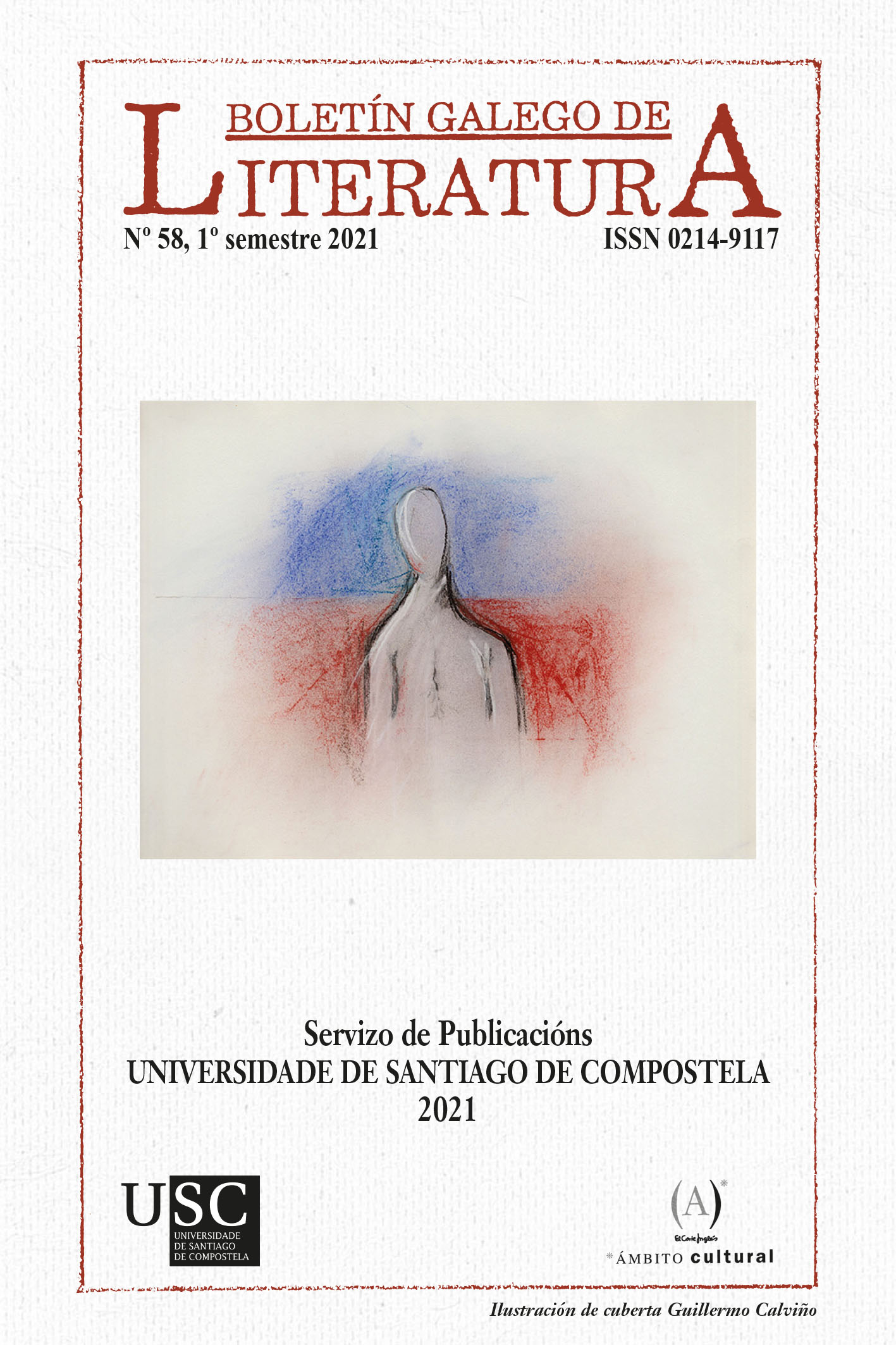A house for Lupe Gómez: space, affect and memory in Camuflaxe (2017)
Main Article Content
Abstract
Camuflaxe, published and recognized in 2017 with the Spanish Critics Award, is one of the last books of poems written by the Galician Lupe Gómez. In its pages, which deal with such intimate issues as childhood, the family home or mother-child ties, there is an underlying commitment of a literary consciousness that seeks to represent the costs of the loss and destruction of both the land and the ways of life connected to Galician countryside. The author articulates a book of poems in which affects and memory intersect in the space of Galician periphery. Those elements will be analyzed in order to understand the way in which they relate to each other and construct the environment that surrounds the poems. Gómez uses poetics as a place of memory so as to denounce a reality that is marked by social injustice and gives rise to a discourse of resistance.
Keywords:
Article Details
References
Bachelard, G. [1957] (2000). La poética del espacio. Fondo de Cultura Económica de Argentina.
Berkeley, G. (2005). A treatise concerning the principles of human knowledge. En G. Berkeley, The works of George Berkeley, vol. 1 (pp. 69-147). Elibron
Classics.
Casas, A. (2013). Glosario para lupenautas. En B. Baltrusch (Ed.), Lupe Gómez: libre e estranxeira. Estudos e traducións (pp. 159-179). Frank & Timme.
Casey, E. S. [1987] (2000). Remembering. A Phenomenological Study. Indiana University Press.
Gaard, G. e Murphy, P. (1998). Ecofeminist Literary Criticism: Theory, Interpretation, Pedagogy. University of Illinois Press.
Gibson, J.J. [1979] (1986). The ecological approach to visual perception. Hillsdale.
Gramsci, A. [1975] (1981-2000). Cuadernos de la cárcel, 6 vols. ERA e Universidad de Puebla.
Gómez, L. (2005). O útero dos cabalos. Espiral Maior.
Gómez, L. (2017). Camuflaxe. Chan da Pólvora.
Hall, E. T. [1966] (1993). La dimensión oculta. Siglo Veintiuno.
Heft, H. e Nazar, J. L. (2000). Evaluating Environmental Scenes Using Dynamic versus Static Displays. Environment and Behavior, 32, 301–322.
Howes, D. (2005). The empire of the senses: the sensual culture reader. Bergs Publishers.
Labrador Méndez, G. (2016). Las Églogas de la Acumulación Originaria. Paisajización, desposesión y memoria demo-poética desde Cantares Gallegos (1863) de Rosalía de Castro. En K. Soriano Salkjelsvik e F. Martínez Pinzón (Ed.), Revisitar el costumbrismo. Cosmopolitismo, pedagogías y modernización en Iberoamérica. Peter Lang.
Lefebvre, H. [1974] (2013). La producción del espacio. Capitán Swing.
López, M. (2008). Paisaxe e nación: a creación discursiva do territorio. Galaxia.
López, M. (2012). Memoria, ecoloxía e identidade na Galiza. En G. Sanmartín Rei (Ed.), Lingua e ecoloxía: VIII Xornadas sobre Lingua e usos (pp. 51-64). Universidade da Coruña.
Massumi, B. (2002). Parables for the Virtual: Movement, Affect, Sensation. Duke University Press.
Nogueira, M. X. (2011). Identidade nación e compromiso na poesía galega do novo século. En M. X. Lama e M. X. Nogueira (Cords.), Poesía galega. Perspectivas críticas e comparadas. Boletín Galego de Literatura, 45, 107-120. https://cutt.ly/jhk2xsT
Nora, P. (1992). Les Lieux de Mémoire: La République, La Nation, Les France, 3 vols. Gallimard.
Pato, C. (2000). m-talá. Edicións Xerais de Galicia.
Rábade Villar, M. d. C. (2010). The concept of resistance in contemporary Galician culture: towards a poetic ecology. Cosmos and history: The Journal of Natural and Social Philosophy, 6 (2), 82-92. https://cutt.ly/Ihk2fdZ
Rábade Villar, M. d. C. (2019). De afectos y desafectos. La representación del mundo rural en la poesía gallega contemporánea. En R. Spiller, A. Calderón Puerta e K. Moszcyzinska Dürst (Eds.), Extremas. Figuras de la felicidad y la furia en la producción cultural ibérica y latinoamericana del siglo XXI. Peter Lang.
Rosenwein, B. H. (2006). Emotional Communities in the Early Middle Ages. Cornell University Press.
Simonsen, K. (2005). Bodies, Sensations, Space and Time: The Contribution from Henri Lefebvre. Geografiska Annaler. Series B, Human Geography, 87 (1), 1-14.
Spinoza, B. [1677] (2001). Ethics. Wordsworth Editions.
Tuan, Y-F. (1997). Space and Place: The perspective of Experience. University of Minnesota Press.
Von Hartenthal, M. e Mitsuko Ono, M. (2011). O espaço percibido: em busca de uma definição conceitual. Arquitecturarevista, 7 (1), 2-8.
VVAA. Diccionario de la Real Academia Española. [en liña]. https://dle.rae.es/
Williams, R. (1977). Marxism and Literature. Oxford University Press.
Williams, R. (2001). El campo y la ciudad. Paidós.







